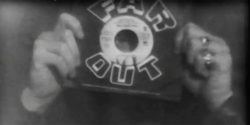I just discovered this fascinating piece of video tape on YouTube, likely dating from the 1970s, documenting a pirate radio and television station operating in my neighborhood, Sunnyside, in Portland, OR. It’s part of an archive of tapes from an archive of The Video Access Project, digitized by the Oregon Historical Society.
It’s truly a wonderful slice of counter-cultural public access television that starts with a man demonstrating how to reconnect a house to the city water supply after it’s been cut off due to non-payment of bills. At the end of the demo, about 19 minutes in, it seamlessly segues to a man with a portable radio playing reggae, who starts explaining that he started putting together radio stations, “for the hell of it.” He goes on to claim that “apparently, half the neighborhood of Sunnyside is involved in the station right now.”
Then the interviewer and camera follows the man into a house, up into its attic where we see a radio studio occupied by several people. In addition to the record players and mixers, he also shows a television transmitter, though we don’t get a glimpse of the programming.
In the title of the video it’s apparently credited to someone named Wayne Waits, whom I found listed in the “Video Directory” section of the magazine Radical Software volume 1 number 5 from 1972, devoted to nascent the independent video production and video art community of the time. Waits was listed as someone with video equipment and expertise, though his street address is care-of community radio station KBOO, when it was located down the street from where I live now.
As an aside, imagine a time when the number of independent private owners of video recording equipment could be listed in in just 13 pages of a magazine. When I consider the fact that most people carry a device in their pocket capable of recording video with four to eight times the resolution, and then transmitting it around the world within seconds, it kind of blows my mind. I have to stop and take a second to awe in how far communications technology has come in my lifetime.
I’m particularly fascinated by the fact that this likely aired on public access TV, where the participants in these ostensibly illicit activities would have been easily identified by any interested authorities. That said, cable TV subscriptions and viewership was much lower at the time, and public access channel viewership probably very, very low. Plus, the show would have been much more ephemeral than today–it would take some 35 years for it to become on-demand and findable to anyone without access to the original reel of tape.
Here’s the whole show below, or you can forward to 18:45 to just catch the pirate radio portion.



